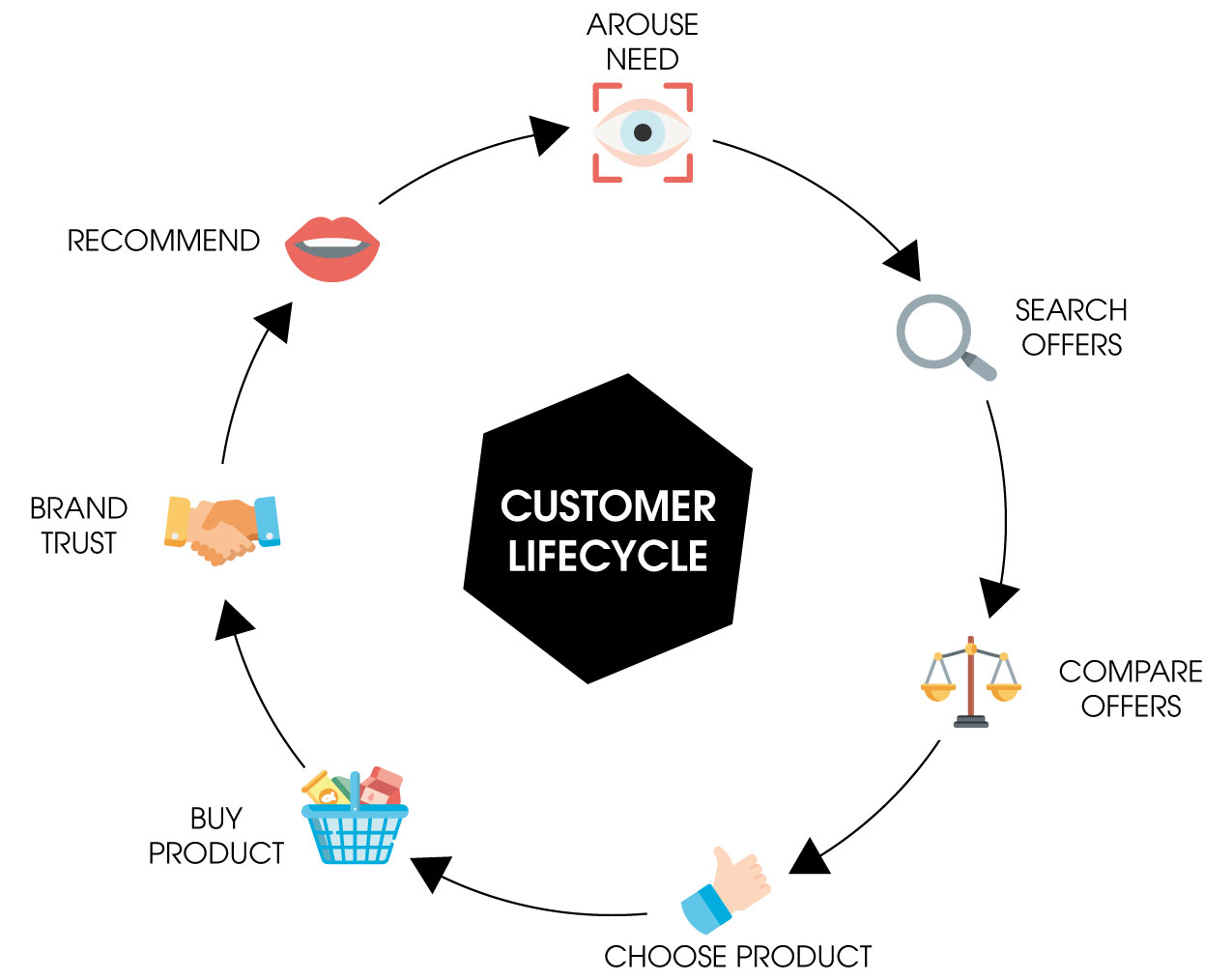The footer is an important element of every website. Nevertheless, it is often treated stepmotherly. But especially for SEO and the user experience, a good footer is very relevant. ... Continue reading


The Customer Lifecycle describes the relationship between a customer and a company. It includes the acquisition of new customers, the retention of existing customers and the recovery of former customers. It thus plays an important role in customer retention. The customer lifecycle originates from the practice of customer relationship management, or CRM for short, and refers to the different phases that a customer goes through with a company in order to be persuaded to make a purchase.
The Customer Lifecycle is divided into a total of 7 phases, which we explain in more detail here.

At the beginning of the customer lifecycle, it is important to capture the user’s attention. In this phase, the potential customer comes into contact with your brand or your product for the first time. For this reason, you should clearly explain to the user why your product is the solution to their search. Don’t immediately try to swing the sales club around, but present the benefits of your product in a simple and understandable way.
The customer’s need has been awakened. Now it’s a matter of remaining visible to him. He may compare your offer with other providers. Here, the targeted placement of Google Ads with the right keywords can help you. The user’s search intention has not changed. Create brand recognition through a strong online presence. It also makes sense to navigate to a landing page that describes your service or product in more detail.
You’ve done it, the customer is again on your website to inform himself. Now provide him with facts that make it clear why your product and your service are right for him. Infographics, product images, before and after comparisons can be helpful here.
The customer has chosen one of your products. Now it’s up to you to make the way to the shopping cart as easy as possible. Nothing is more annoying for a user than a non-transparent registration and payment process. Orientate yourself for these pages on best practice examples for user experience and user interface. This will reduce your bounce rate and increase your conversion rate. To increase the dwell-time, you could also show them products or services that customers who have already bought from you are interested in.
The customer’s purchase is complete. However, you should not rest on your laurels. Offer your customer a newsletter subscription after the purchase, for example. In this way, he will not miss any innovations and will always be up to date. Information on product care, examples of use or instructions can also be highly relevant for the customer after the purchase and create trust in your brand. Make these available to him, because he will feel that he is in good hands with you.
You’ve turned a potential customer into a customer. Now it’s time to turn him into a repeat customer. Give him incentives to remember the positive experience of buying from you. If the data was collected by you, you can send him happy birthday with a birthday discount. If the customer hasn’t bought for a while, emails à la “You haven’t been around for a while – we miss you!” are also a useful marketing tool to lure the customer back to your website.
The relationship with your customer is strengthened and you have proven the credibility of your products and services. Use this to encourage your customer to write a positive review. Nothing is more meaningful than reviews from users. This can be done directly in your store or in cooperation with credible influencers in the context of social media marketing.
Now that you’ve learned about the different stages of the customer lifecycle, it’s time to create your own campaign.
A customer lifecycle campaign is an excellent way for you to attract and retain customers. However, building a successful campaign requires careful planning and execution. The first step in creating a customer lifecycle campaign is to understand the lifecycle of your customers. To do this, you need to familiarize yourself with your existing customer base and your future target group. Additionally, think about the added value your products and services offer to the customer. It also makes sense to include what your customers expect from you, what needs and wishes they have and what problems they would like to solve with your products and services.
Once you have structured this information, you can design your campaign. Your focus should be on supporting your customers at every stage of their lifecycle. To do this, you can provide them with a wide variety of information in combination with a balanced marketing mix. For example:
There are no limits to your creativity.
It’s also important to define clear goals and metrics to track the success of your campaign. Regularly monitor your KPIs, such as open rates, clicks, and conversion rates, to make sure your campaign is getting the results you want.
Marketing for the customer lifecycle is essential to identify problems as soon as possible. This creates longer customer loyalty for you and, in the best case, reactivates customers.
If you receive feedback from a customer who was not 100% satisfied with your product or service, you should not put it aside lightly, but check it carefully. Often customers who complain are angry at first. However, if you have an excellent complaints management system and take care of the issue immediately, the complaining customer can still become an existing customer.
You should also make sure that repeat orders for existing customers are as simple as possible. An overview of previous orders in the customer’s profile will help you here. This way, the customer can quickly add the products to the shopping cart and order them again.

In your chosen marketing measures, always make sure that you vary the way you address the different customer groups. A potential new customer needs different information than an existing customer. A satisfied existing customer wants to be addressed differently than a customer you want to win back.
You want to learn more about exciting topics?